Landscaping with flowers: 11 ways to create a floral feast
Garden designers share their go-to ideas for landscaping with flowers so you can create a gorgeous planting scheme in your plot
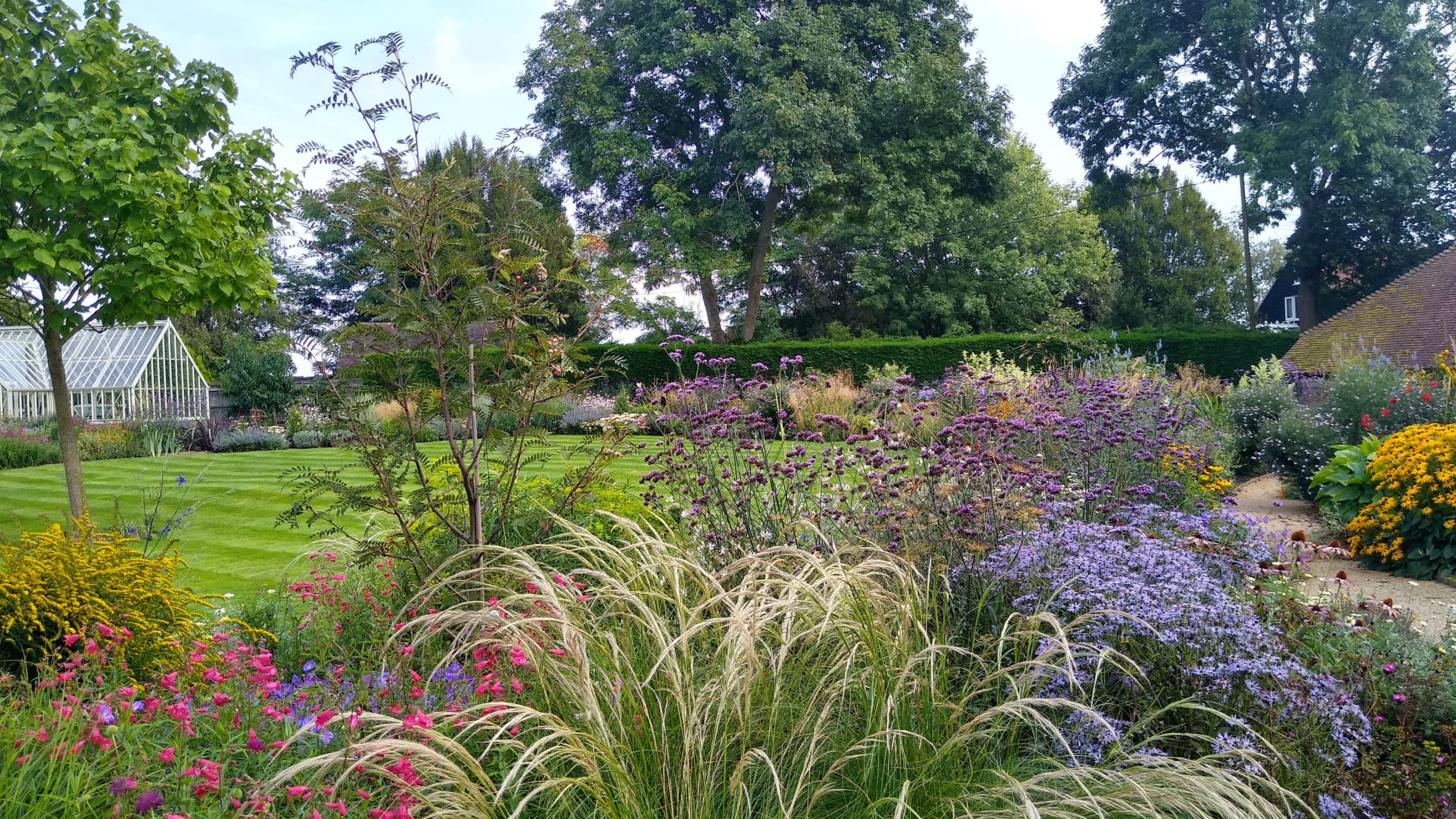

Knowing where to start when landscaping with flowers is not always an easy thing. Thinking about where to position your flowers, which flowers to choose and how to combine them in a cohesive way takes some research on your part.
Have you ever looked at a beautifully landscaped garden, which is alive with flowers and wished that you could make that happen in your own garden? Indeed, who hasn't! Achieving the look you want might seem like a bit of an unrealistic aim, but armed with the right knowledge, there's no reason you can't plan your very own plant paradise in your garden.
Among many other things, garden designers really know their stuff when it comes to using flowers to create beautiful landscapes in almost any outdoor space. So I approached five experts on how to successfully bring flowers into garden landscaping. All of their ideas can be easily applied to your own unique planting project.
So before you start sowing seeds and planting up flower beds, plan your landscaping ideas with a little guidance from these top garden design experts so you'll have the best chance at a beautifully landscaped garden that's teeming with blooms.
Create a stunning garden with our expert tips on landscaping with flowers
How much of your backyard landscaping should be given to flowers is purely down to your own personal choice, how much time you have and also the size of the area you want to cultivate.
'A rough rule of thumb is 70% flowers,' says head gardener Sarah Mead at Yeo Valley Organic Garden. 'But don’t forget trees, shrubs and hedges have flowers too, as do some of our favorite weeds.'
Whether or not you stick to this 70% guide, our favourite ideas for landscaping with flowers are a great place to start your when transforming your plot.
1. Position flowers in view of the house for visual impact
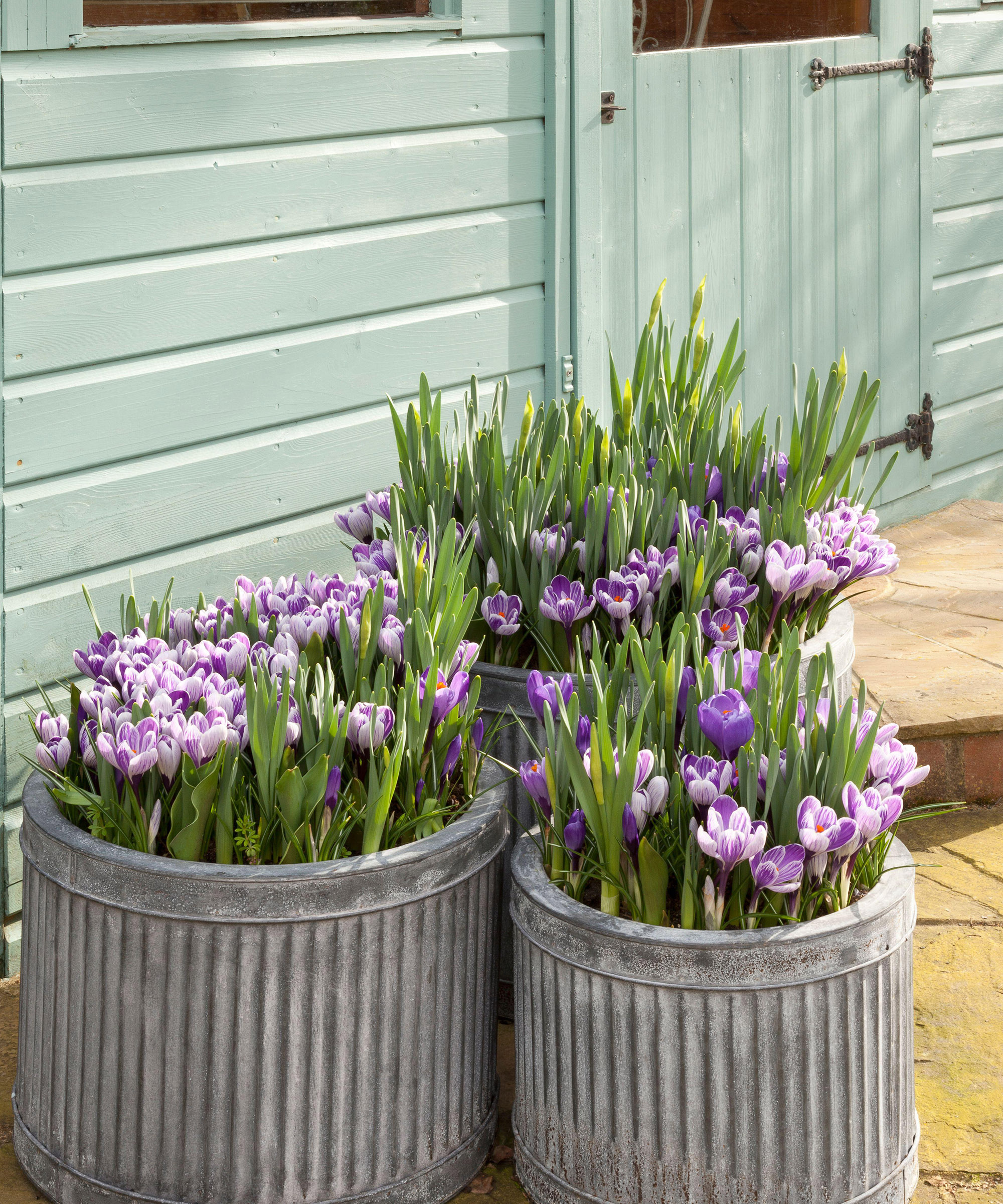
Don't hide your spring bulbs away at the bottom of your garden!
It's important to have some of your landscaping with flowers where it can be enjoyed at all times of the year. This is particularly important outside of the summer months when you may not be spending as much time outdoors.
Plant early spring bulbs where you can see them from the house, such as outside your kitchen window, on the patio, or even as part of your front yard landscaping so you can walk past them on your way into the house each day. 'It sounds obvious,' says Sarah Mead, 'but there is no point planting something lovely like a Daphne down the bottom of the garden where, on a cold and rainy February day, it is flowering its socks off but no-one will know.'
Sarah suggests positioning something as simple as a garden planter packed with crocus where it can be viewed from a window. That won't fail to cheer up a dark day!
2. Overcome problem areas by adding the right flowers
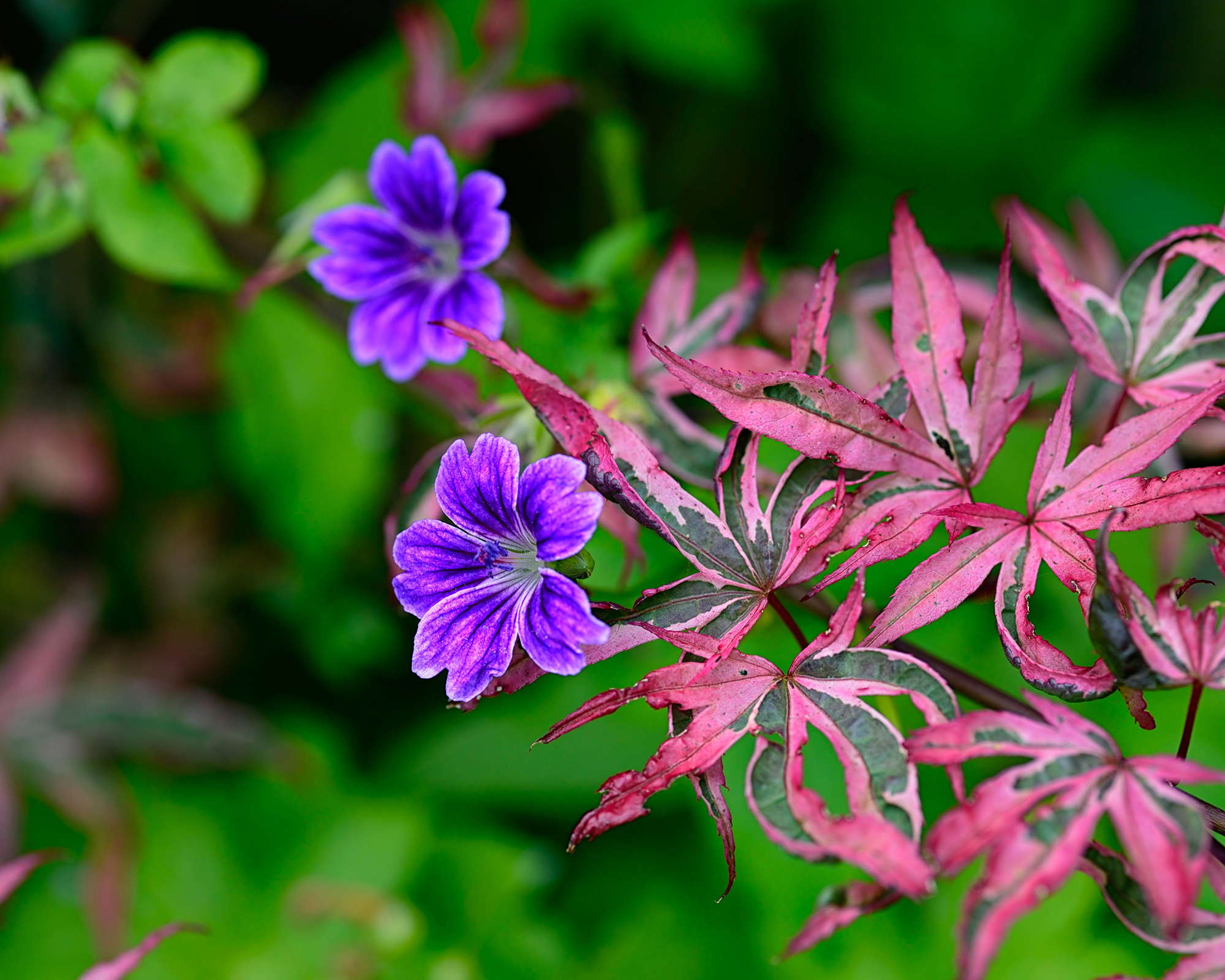
Henrietta Murray Wicks recommends including easy-to-grow flowers like geranium Nodosum 'Clos du Coudray' in your landscaping
There are very few areas where nothing at all can grow. And if you do your research you can avoid one of the most common landscaping mistakes of planting something in the wrong conditions.
From drought tolerant plants which like poor soils to shade loving plants which will thrive in a neglected corner, there is always an option for tricky areas of the garden. So rather than feeling like you have to abandon problem areas altogether, choose a flower variety which will thrive no matter the situation.
Garden designer Henrietta Murray Wicks has just such a plant which she loves for tricky spots. 'I have been recently introduced to a variety of hardy geranium called 'Clos du Coudray' by Chris Marchant of Orchard Dene Nursery where it was used a lot in the Piet Oudoulf garden at Maggie's in Sutton. It is an incredibly useful little plant, even flowering in dry shade.
'It's a very delicate pinky purple flower that blooms for a very long time. It's really good for when you don't know what to plant in a difficult corner.'
3. Use reliable flowers in your landscaping
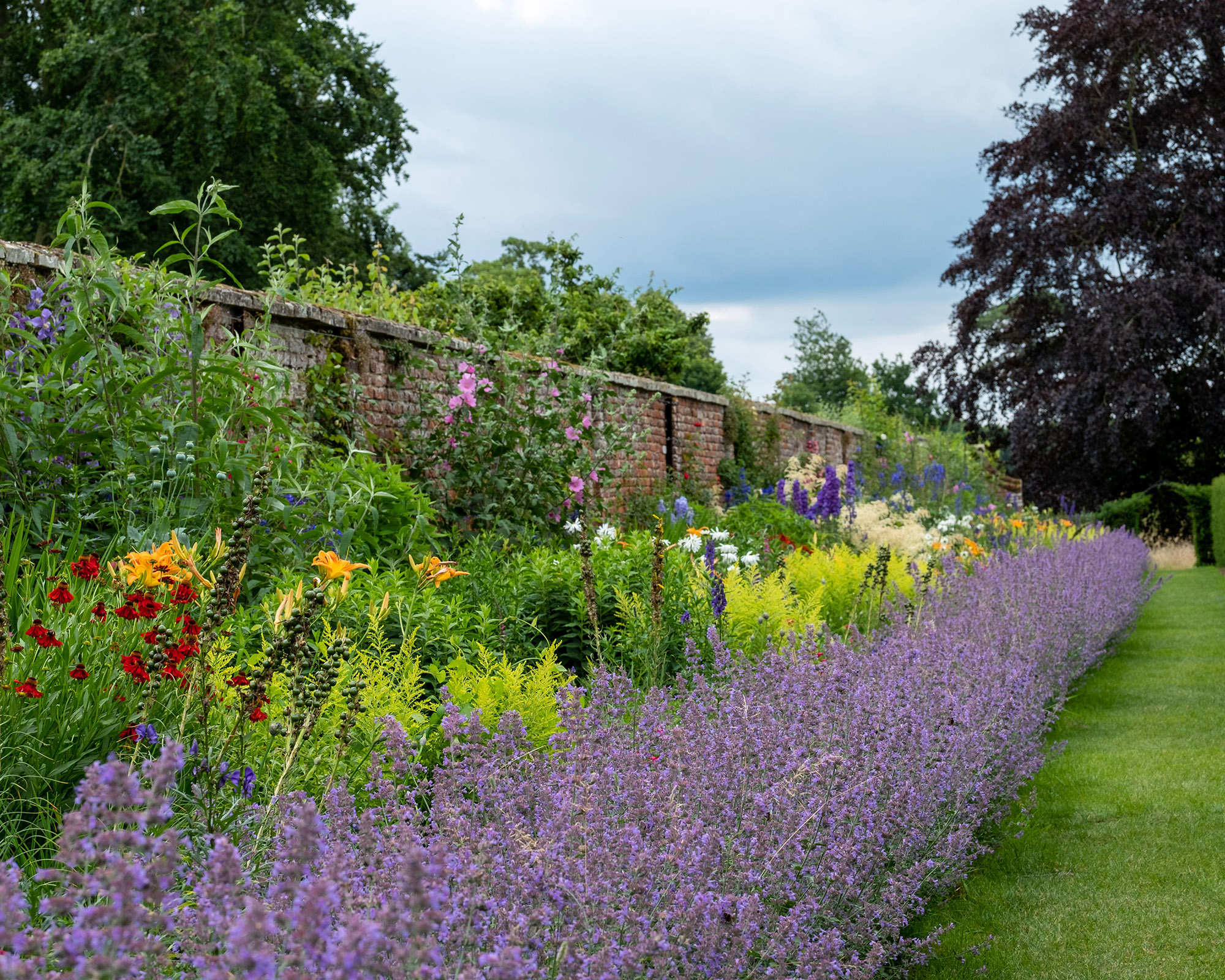
Reliable flowers should make up the backbone of your landscaping
If you're planning a new floral landscape it's important to select plants which will deliver the goods. For example, if your garden has a problem with slugs, then planting something like lupins, though beautiful, will result in them being devoured quickly. This won't do much for the longevity of your landscaping with flowers.
A network of reliable bloomers should therefore be factored into your plans, which will help hold your look together when other flowers die back.
Henrietta Murray Wicks likes to use Nepeta racemosa 'Walker's Low' for this purpose. 'It is an absolute stalwart of a plant, useful for so many situations and especially whilst new gardens are beginning to settle in. They are very easy to grow, can be left to do their own thing but have such a big impact and help knit planting schemes together. They are a brilliant bee friendly plant, so are sure to encourage wildlife to your garden as well.'
As shown in the above planting scheme, it also makes a brilliant garden edging idea at the front of a deep border.
4. Plant pops of color across a green background
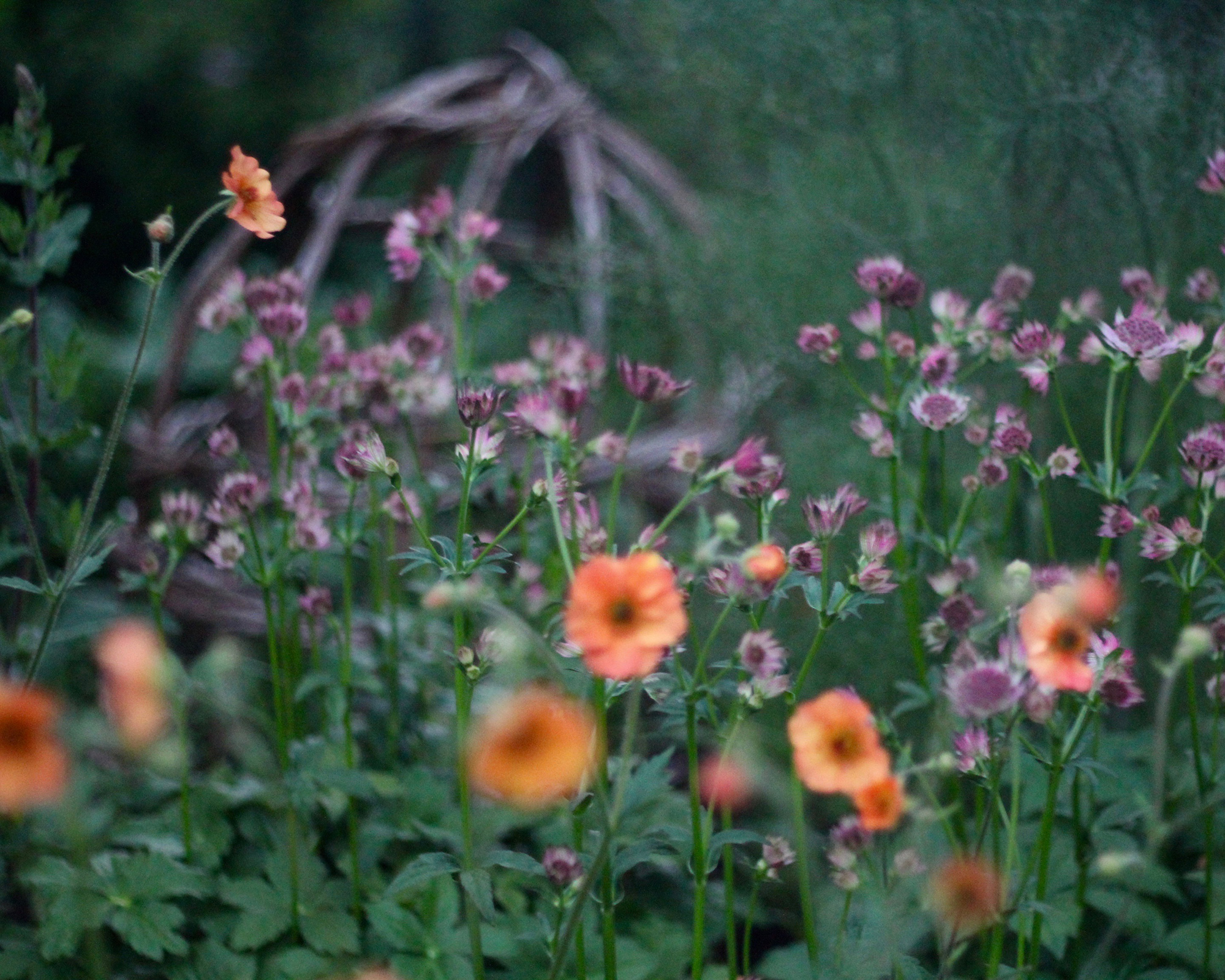
Astrantia major 'Roma' enhances the bronze foliage of the Foeniculum vulgare 'Purpureum'
In garden design ideas, the background is as important as the foreground. To create depth in your landscaping with flowers you should think about what surrounds them as well as the flowers themselves.
Henrietta Murray Wicks feels strongly that it's always important to think about what is around the flowers and their backdrop. 'Pairing colors to make some others stand out more is really interesting and can enhance the overall planting scheme hugely. I often use bronze fennel paired with astrantia, because the foliage of the fennel is such a useful color to enhance the pinky red of the astrantia. A green hedge is also a great backdrop to show the true colors of a plant.'
So when you're planning where to put your flowers, consider what will be surrounding them. You might want to make use of lush green hedging plants as a way to make pink plants pop. Or you might have a new garden fence color which would be the ideal background for a tapestry of bright climbing roses.
5. Create cohesion by repeating flowers
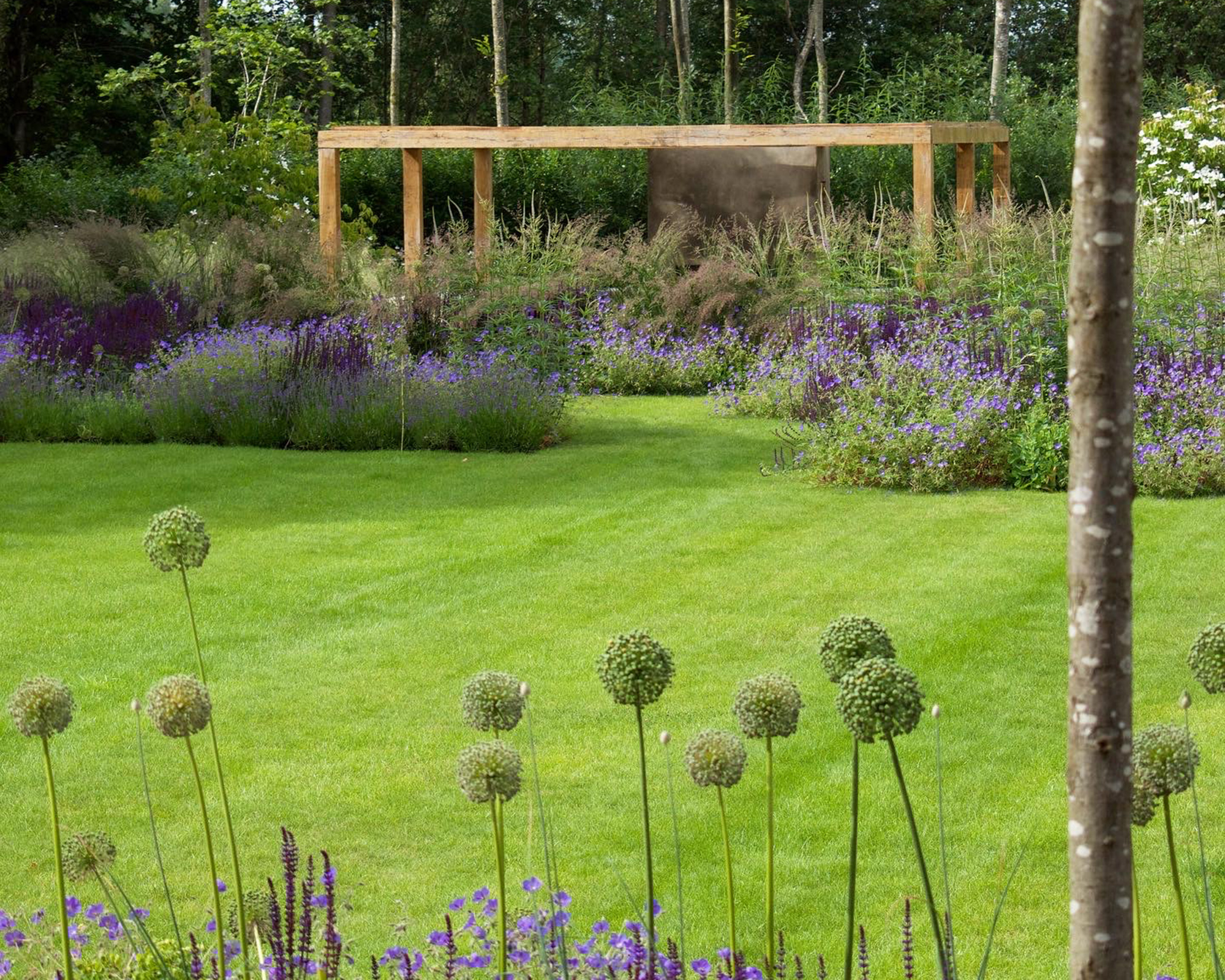
Garden designed by Polly WiIlkinson with repeating planting of a select few flowers
This is an excellent tip if you're looking for low maintenance landscaping ideas or perhaps if you've previously struggled with creating a cohesive scheme. Having fewer plant varieties is a technique which garden designers use to create a sense of rhythm to their landscaping with flowers.
'Where you're using flowers, make sure they can be seen as a larger group,' says Henrietta, 'rather than having larger quantities of too many different flowers, focus on a specific planting palette and have larger numbers of fewer plants.'
Garden designer Polly Wilkinson also practises repetition in her designs. 'The trick is to use a cluster of the same plants (odd numbers ideally) which are repeated throughout the garden to give rhythm, rather than many different, singular plants which can look confused and cluttered.'
6. Dot flowers amongst existing shrubs
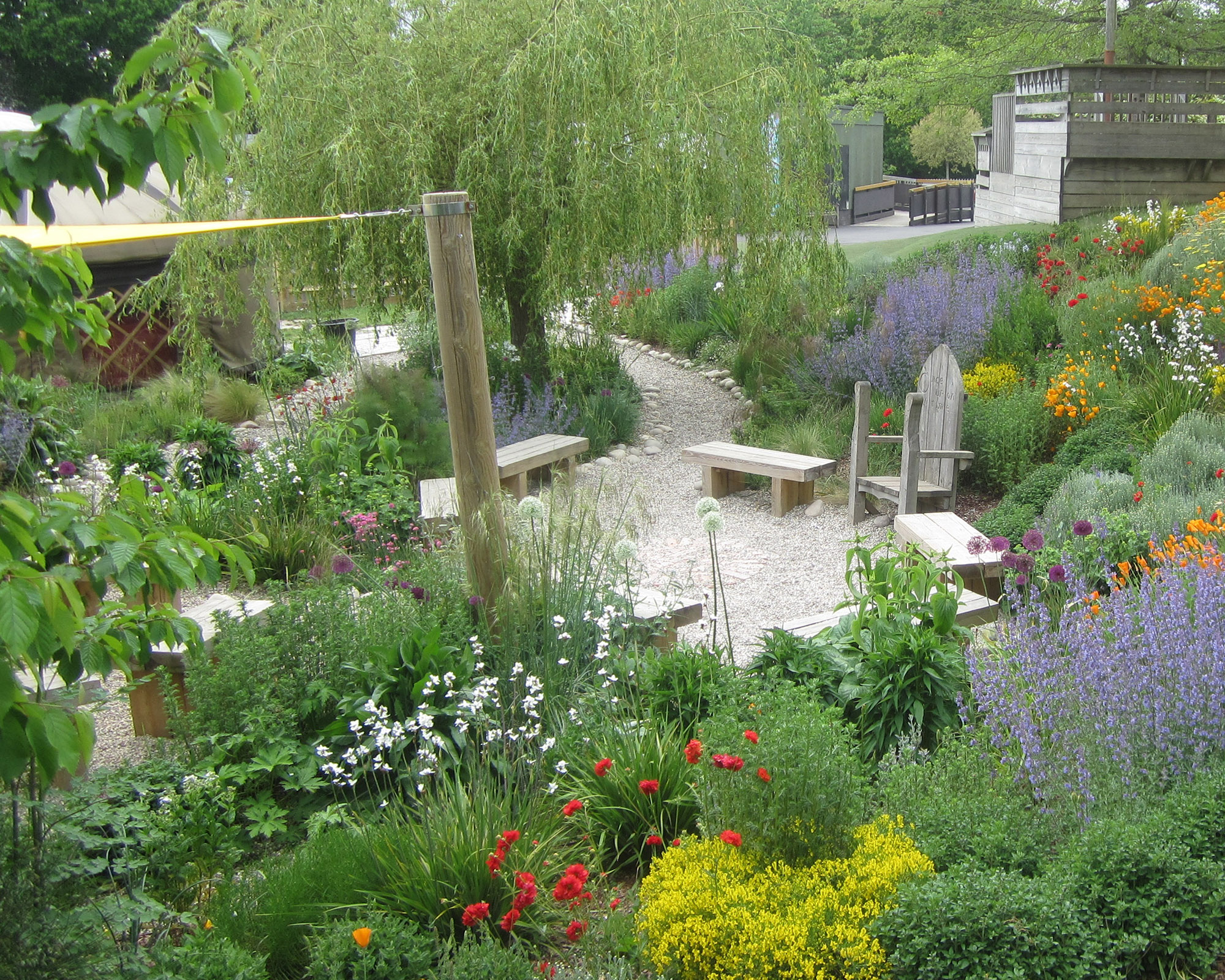
Form and leaf texture are just as important as petal color when choosing flowers
Garden designer Kristina Clode believes that while flowers are beautiful they should be the icing on the cake, rather than the backbone of the garden. 'Contrasting form and leaf texture are generally the most important in plant choice, providing year round structure to the garden; plants generally only flower for a few weeks of the year, so it's really important how they look and interact with one another the rest of the time.'
So when considering which flowers to use in a garden border Kristina always considers the form, leaf texture, leaf persistence (evergreen or deciduous), height and spread as well as the flowering time, flower form and color and sometimes scent of leaf or flower.
'I will always try to include a fair few plants which flower for as long as possible in summer in a design, to maximize the impact. However, I also like to extend the seasons to provide a flowering display as long as I can throughout the year. So I will include spring bulbs, late summer bulbs and autumn bloomers and, where possible, even winter flowering shrubs.'
7. Build up a picture with the perfect color scheme
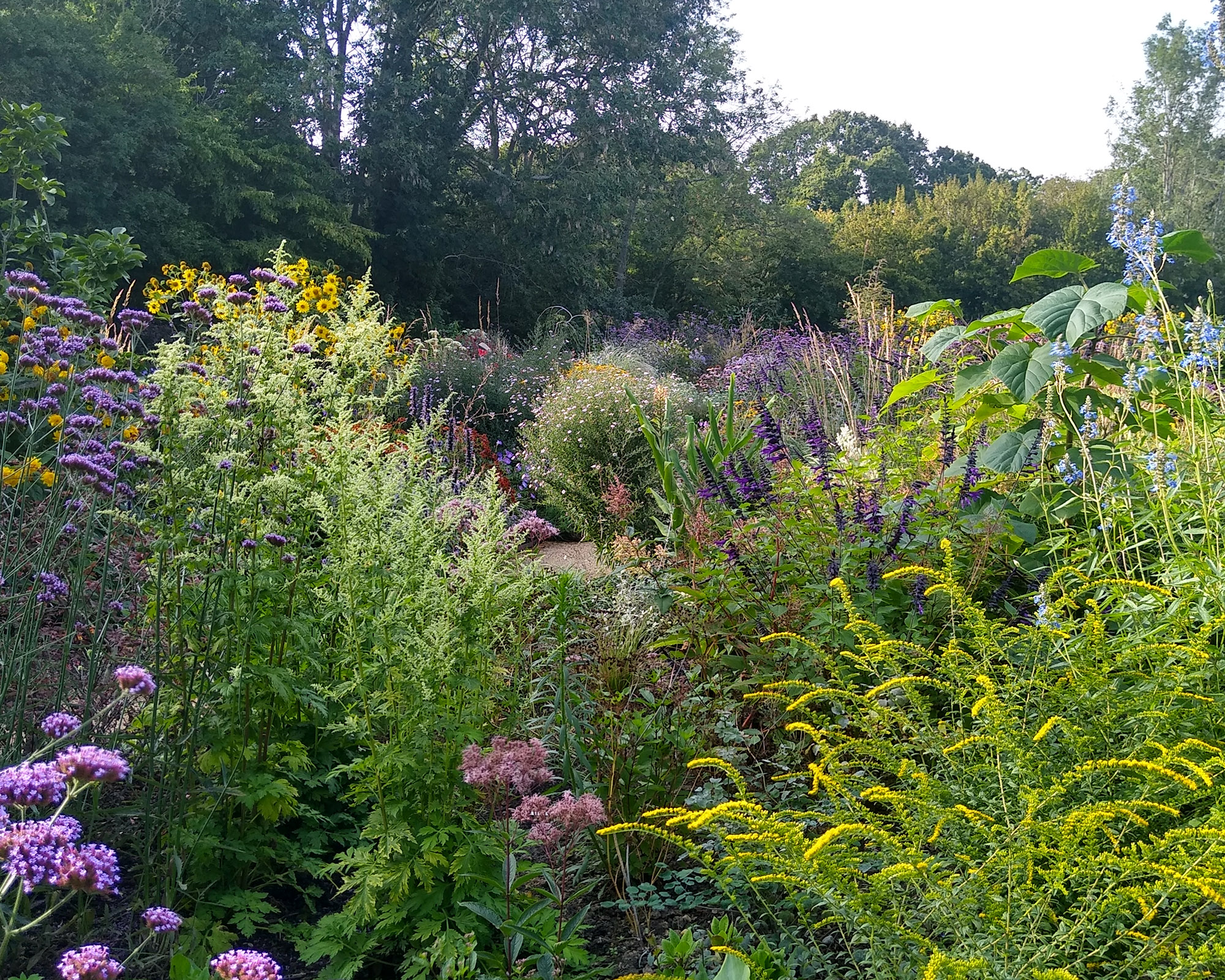
This mixed border designed by Kristina Clode contains Salvia 'Amistad', Artemisia lactiflora, Verbena bonariensis, Paulownia tomentosa, Solidago rugosa 'Firecracker', Salvia uliginosa, Helianthus 'Capenoch Star'
Learning how to plant a garden for year round color is perhaps the most difficult thing to consider when landscaping with flowers.
But the trick, according to Kristina Clode is to not feel like you have to stick to any hard and fast rules about what color of flowers you can and can't mix together in your garden color scheme. 'Traditionally, colors which sit together on the color-wheel are harmonious and those opposite one another are contrasting but complementary, but sometimes flower colors that should clash can actually work well together too.'
When choosing flowers for her landscaping, Kristina considers many aspects of the plant in addition to the flower shape and color such as habit, structure and leaf texture and how these contrast with their neighbors. 'I do try to include at least a pop of bright color in a border here and there as an unexpected interlude, as using all harmonious colors can be a little dull over a wide area.'
8. Include a mix of flower heights and textures in your landscaping
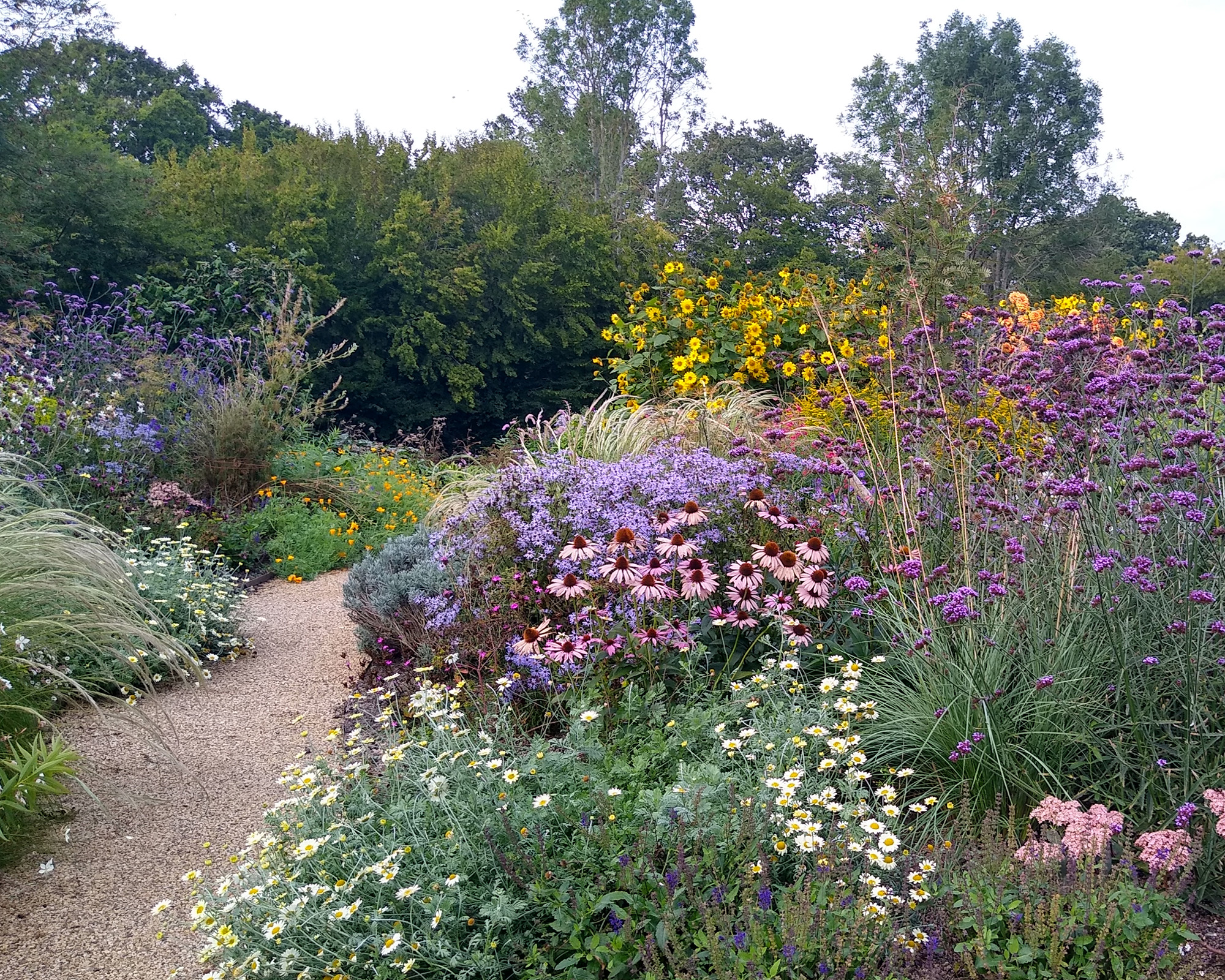
Kristina's border can be recreated with Stipa ichu, Euribya x herveyi, Penstemon 'Garnet', Geranium 'Rozanne', Sorbus vilmorinii, Solidago rugosa 'Firecracker', Verbena bonariensis, Echinacea purpurea 'Magnus', Anthemis tinctoria 'Sauce Hollandaise', Oneothera lindheimeri 'Whirling Butterflies', Helianthus 'Capenoch Star'
When planning your landscaping with flowers, try and play around with the different heights and textures and how they work together in your scheme.
Kristina Clode generally puts tall perennials at the back of the border, often to fill space between shrubs which need room to expand to their full spread over time. 'I will also try to run a few of them into the middle of the border to ensure the plants don't look like they are in straight line blocks of height,' she says.
In the middle of the flower bed she places mid-height perennials, some shrubs underplanted with lower perennials and bulbs, plus a few of the taller perennials and shorter perennials spreading out from a grouping at the front or back to blur the height lines. At the front are the shorter perennials with a few of the mid height ones coming to the front in places to mix it up a bit.
When considering the texture of plants Kristina advises looking at how fine or coarse the leaves are and to some extent the habit or structure of the leaves. 'I always try to mix up textures so that the plant combinations are visually interesting next to one another, even when not in flower,' she says. 'An example of contrasting foliage would be placing a hosta next to a filigree fern like Matteuccia struthiopteris, or a Geranium 'Rozanne' next to a Libertia chilensis.'
9. Choose long flowering plants to soften hard landscaping
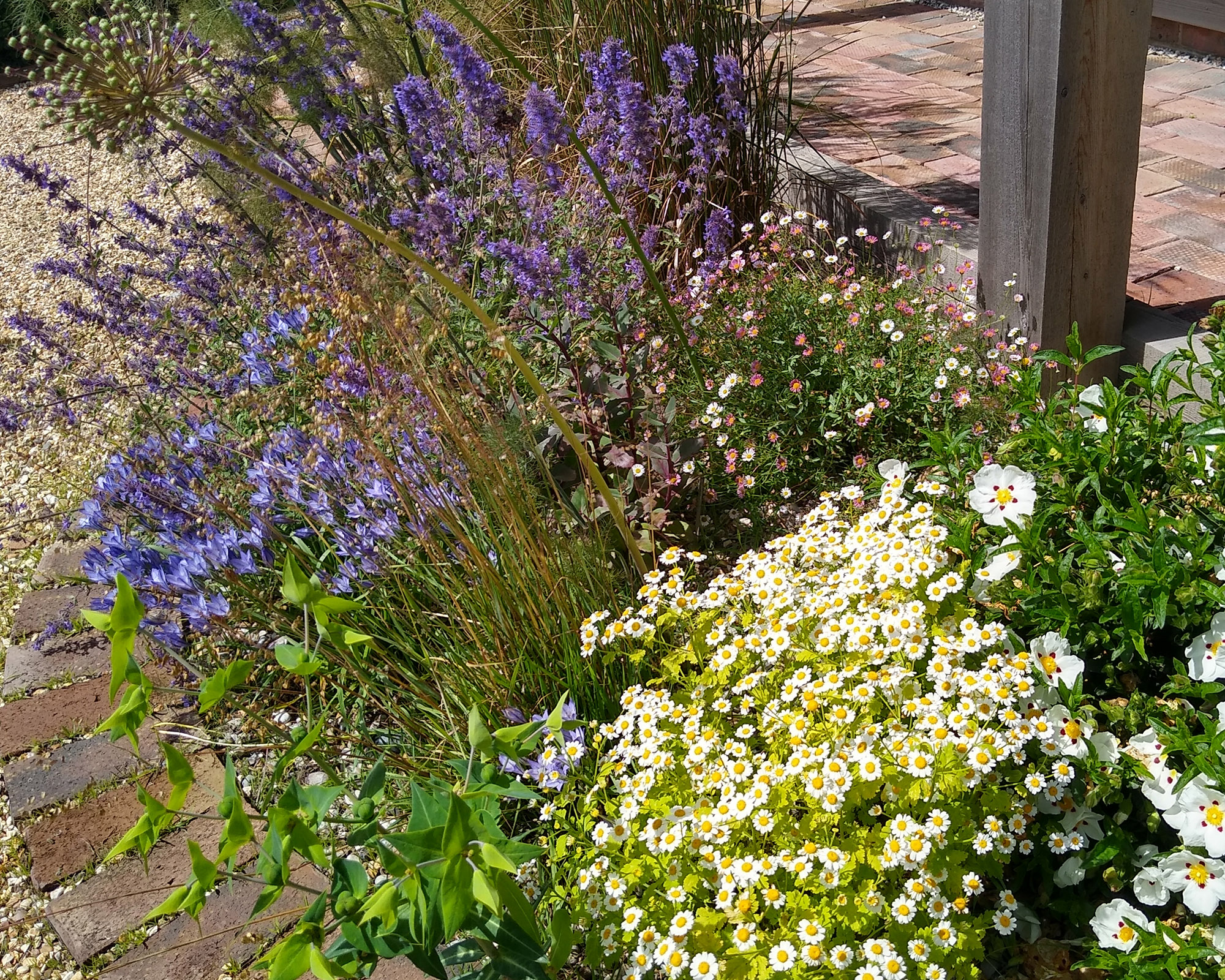
Easy bloomers can be positioned in beds cut out around seating areas
Selecting long flowering plants for your landscaping makes sense on many levels. And reliable bloomers which can be left to take care of themselves will be ideal for filling gaps in hard landscaping. This will also ensure that you're providing valuable sources of food for pollinators.
'I always like to extend the seasons by including plants that bloom in early spring or late summer/autumn,' says Kristina Clode. 'And this also provides nectar for pollinators when other sources are scarce.'
'Spring is a time when many woodland plants which grow in partial shade flower,' says Kristina. 'Many of my go to woodland plants not only have lovely flowers but also have other features. Omphalodes cappadocica 'Cherry Ingram' has striking deep blue flowers and evergreen foliage for year round presence. Brunnera macrophylla 'Jack Frost' also has very pretty blue flowers with arresting silver variegated foliage.'
In late summer and early autumn Kristina likes Aster 'Little Carlow or Eurybia x herveyi which have tall blue daisies that grow in partial shade. 'Hylotelephium (Sedum) 'Matrona' has beautiful pollinator-friendly dense heads of flowers from summer into autumn and the fleshy purple flushed succulent foliage is texturally attractive in its own right, it loves sunny well-drained soil types.'
10. Save money by using more flowers and less hard landscaping
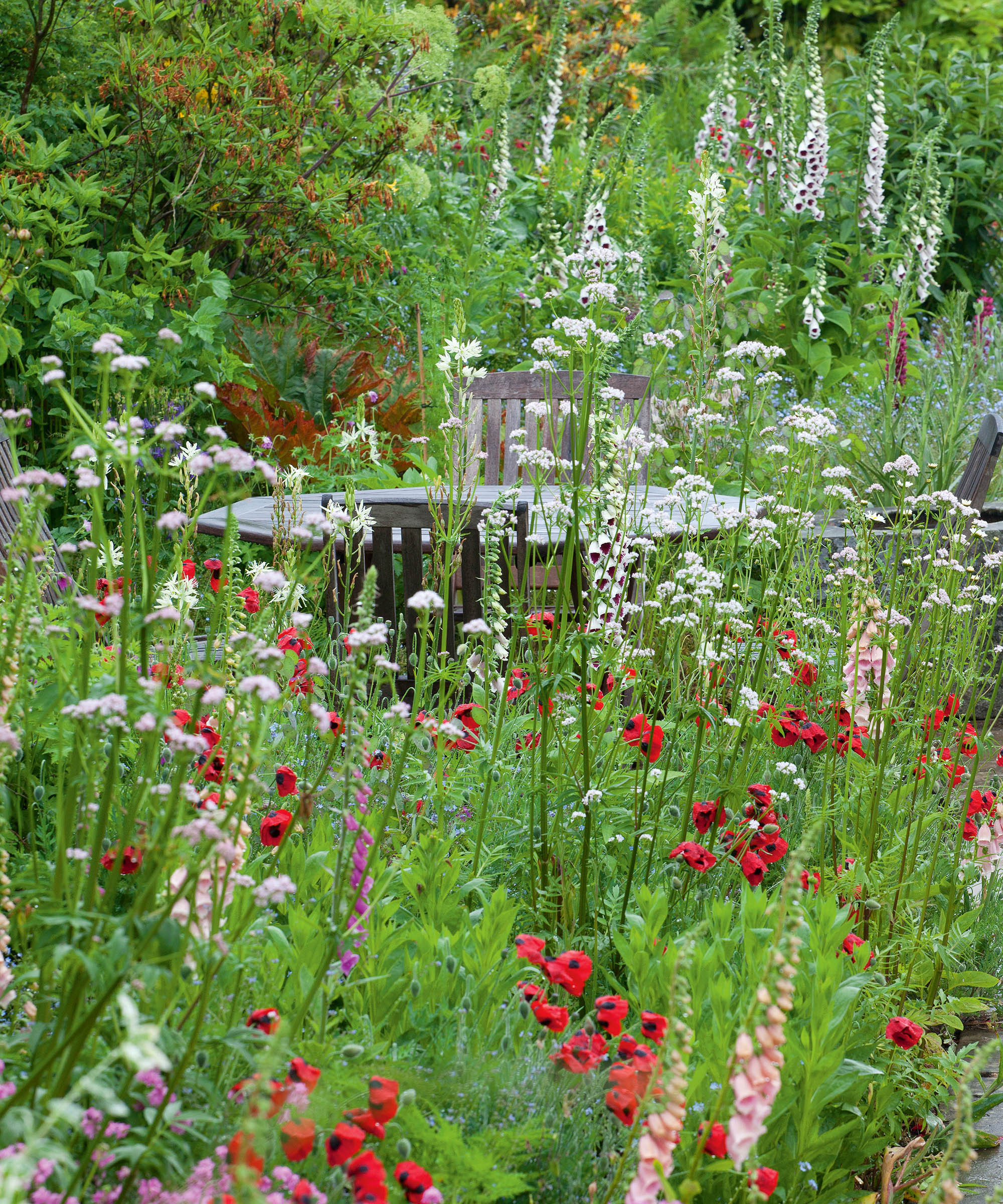
Consider giving over less space to hard landscaping and more to your flowers
If you're trying to decide how much of your landscaping should be dedicated to flowers, the ideal answer would be as much as possible. This depends on how big an area you need for outdoor living spaces and how much time you have to maintain your flowers.
Garden designer Lottie Delamain feels that ideally, planting should be the bulk of your garden. 'It's better for the environment and drainage, better for pollinators and also cheaper to implement than lots of hard landscaping,' says Lottie. 'However it can require maintenance.'
An effective cheap landscaping idea is to plant a wildflower meadow, adds Lottie. 'It's a great way to fill a large area in a low cost and low maintenance way.'
11. Use grasses as a backdrop to your planting
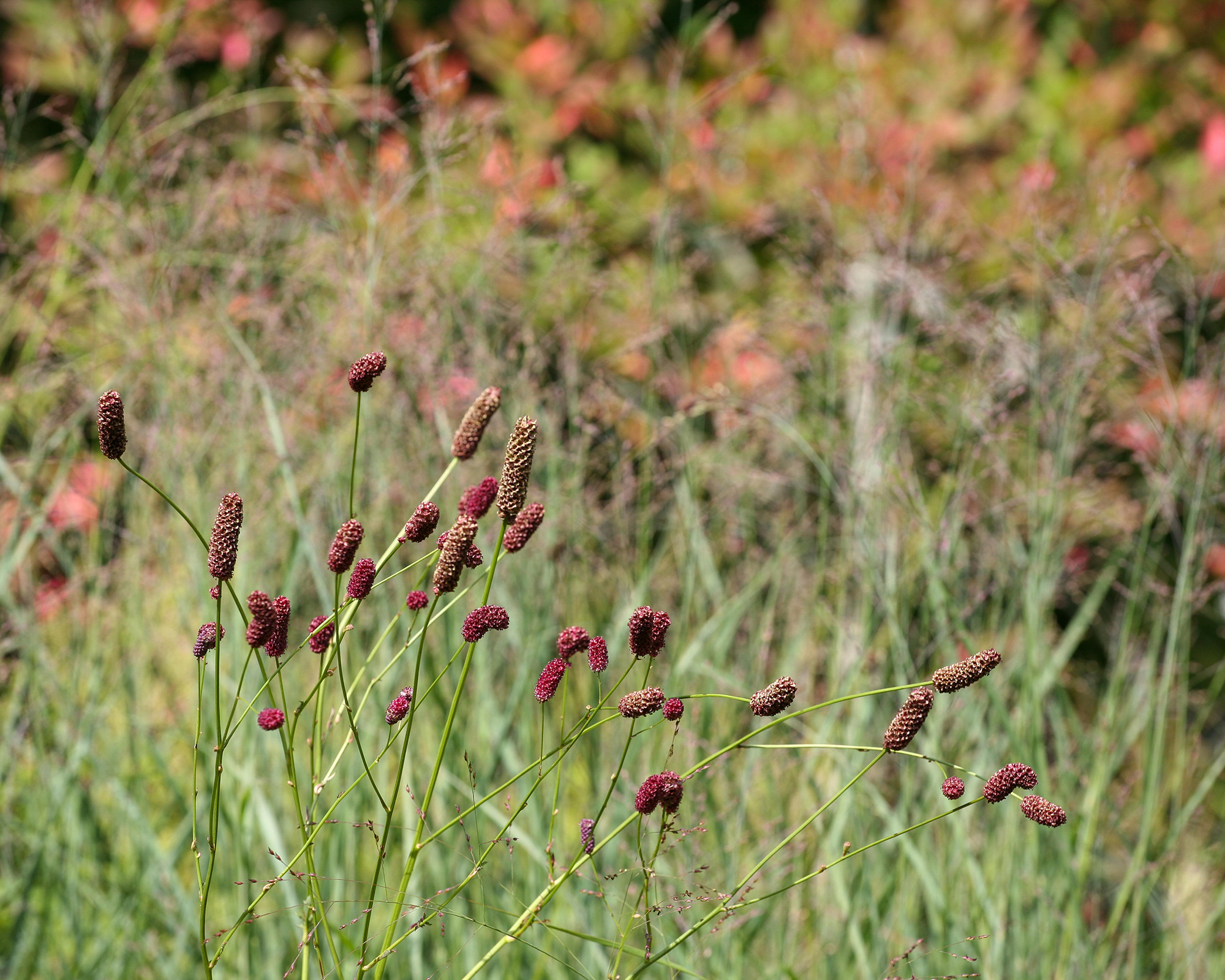
Sanguisorba officinalis “Red Thunder”
'I love landscaping with grasses as it's a fantastic way to add texture and movement to a garden and they act as a lovely neutral mesh or backdrop to showcase other plants with more distinctive pops of color,' says Lottie Delamain.
'Deep maroon is a color I am drawn to at the moment, it works so well with lots of other colors. Favourites include Sanguisorba officinalis 'Red Thunder' and Knautia Macedonia.'
Where should I grow flowers in my garden?
'All parts of a garden need flowers of some kind, whether it's a front or back garden, cultivated border, kitchen garden, pond, bog garden or a wildflower meadow,' advises Kristina Clode.
'However, areas near the house which are walked through and looked at on a daily basis, will really benefit from a long display of flowering plants. A sunny south-facing garden border will offer maximum potential for a wide range of long-flowering summer plants.'
More shady areas will lend themselves to a spring display of woodland plants according to Kristina. 'There are flowers for all aspects, soil types and maintenance level and they don't just have to be perennials; annuals, shrubs, trees, different types of ornamental grasses and bulbs all flower too and have their part to play in a rich garden tapestry.'
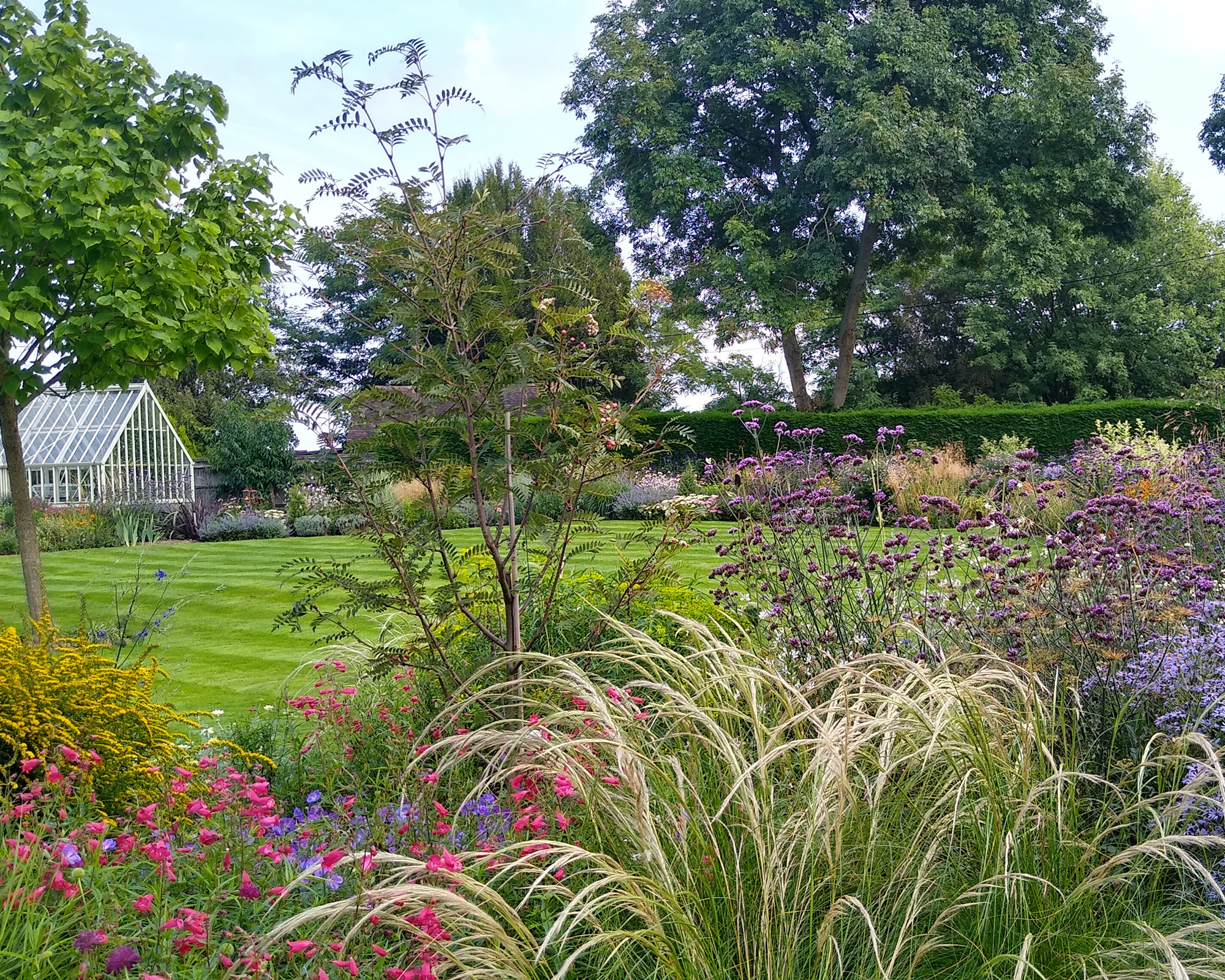
When you're landscaping with flowers make sure you mix in shrubs and evergreens
How do you organize plants in your landscaping?
Landscaping with shrubs to create mixed borders will give structure to the garden, and if they're well chosen will also have attractive flowers over a long period, plus these can often be scented too.
Kristina Clode often includes repeat flowering English roses in her landscaping with flowers: 'My favorites are 'Gertrude Jekyll' and 'Desdemona' by David Austin, but there are many to choose from in all sizes and colors.'
In a sunny spot she likes Cistus x pulverulentus 'Sunset' or Cistus × dansereaui 'decumbens', each flower lasts a day but they are plentiful and keep coming, plus they are evergreen so have year round presence.
For plants for pollinators she advises choosing flowers with single, open blooms, where the stamens are visible and available for harvesting. 'Some double dahlias and roses have been bred to such an extent that their pollen producing stamens have all but disappeared,' she says.
There are also half-hardy perennials such as Salvia 'Amistad' and dahlias which offer such rich color in late summer that Kristina thinks can be worth including. With a caveat that they should be lifted in fall and overwintered under glass to ensure their survival.

Teresa has worked as an Editor on a number of gardening magazines for three years now. So she is lucky enough to see and write about gardening across all sizes, budgets and abilities. She recently moved into her first home and the garden is a real project! Currently she is relishing planning her own design and planting schemes. What she is most passionate about when it comes to gardening are the positive effects it has on our mental health to grow and care for plants, as well as being great for the environment too and help provide food and shelter for wildlife.
